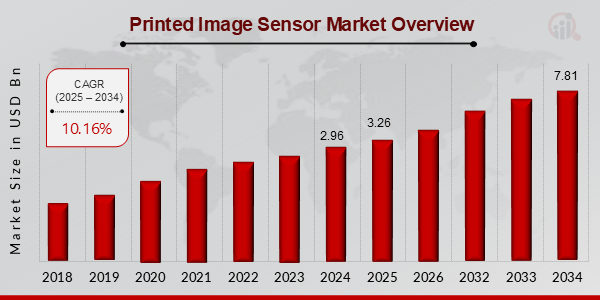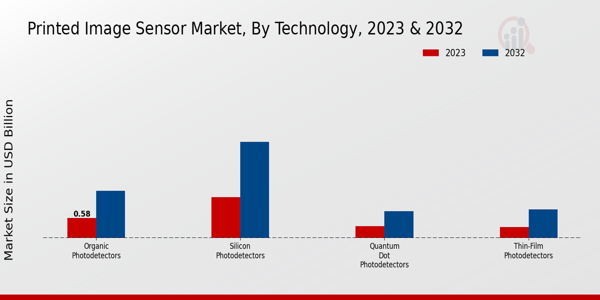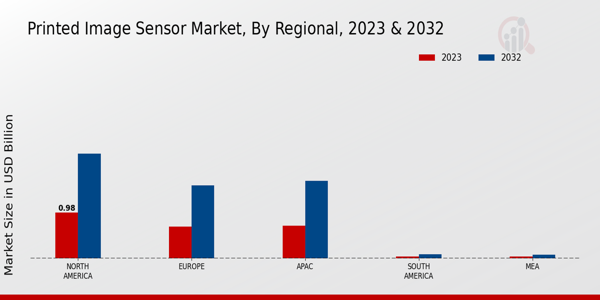Printed Image Sensor Market Overview
Printed Image Sensor Market is projected to grow from USD 3.26 Billion in 2025 to USD 7.81 Billion by 2034, exhibiting a compound annual growth rate (CAGR) of 10.16% during the forecast period (2025 - 2034). Additionally, the market size for Printed Image Sensor Market was valued at USD 2.96 billion in 2024.
Key Printed Image Sensor Market Trends Highlighted
The Printed Image Sensor Market is currently influenced by several key drivers. Increasing demand for smaller and more efficient electronic devices is pushing manufacturers to innovate in sensor technology. This shift is significantly seen in the consumer electronics segment, where image quality and compact design are critical. Moreover, the growing adoption of automation in industries such as automotive and healthcare is enhancing the need for advanced imaging solutions.
The rise of smart devices and the Internet of Things (IoT) further propel the demand for printed image sensors, as these technologies require efficient mechanisms for capturing and processing visual data.The market has many opportunities, especially influenced by the progress of many materials and fabrication technologies in tandem. It would be worthwhile to investigate the use of image sensors integrated into wearable electronics and smart home devices. More room for growth is, however, also possible in the fields of security and surveillance, which heavily require quality imaging.
Due to the continuous development of organic and flexible image sensors, new possibilities for applications that otherwise could have only utilized conventional sensors appear. Thus, with the accumulating recognition of these advanced technologies by different sectors, the prospects for market growth become more optimistic. Recent trends indicate a shift towards environmentally friendly materials in sensor production, aligning with global sustainability efforts. The development of biodegradable and recyclable components is gaining traction, responding to consumer demand for eco-friendly products. Furthermore, there is a noticeable increase in collaboration among tech companies to enhance sensor functionalities through artificial intelligence and machine learning.
Such collaborations are likely to lead to the creation of smarter image sensors that can adapt to various lighting conditions and scenes, offering improved performance across applications. As these trends continue to shape the landscape, the printed image sensor market is expected to evolve dynamically, offering new opportunities for developers and manufacturers alike.
Figure 1 Printed Image Sensor Market Overview (2025-2034)

Source: Primary Research, Secondary Research, Market Research Future Database and Analyst Review
Printed Image Sensor Market Drivers
Increasing Demand for Advanced Imaging Technologies
The surge in demand for advanced imaging technologies is one of the primary drivers fueling the growth of the Printed Image Sensor Market Industry. With rapid advancements in technology and increasing applications in sectors such as consumer electronics, automotive, healthcare, and security, the need for enhanced imaging capabilities has risen. Printed image sensors, which offer attributes such as flexibility, lightweight design, and cost-effectiveness, are becoming essential components in modern devices. For instance, in consumer electronics, smartphones and cameras leverage printed image sensors to deliver high-quality images with improved resolution and reduced power consumption.
Additionally, sectors like automotive are adopting these sensors for advanced driver-assistance systems (ADAS) and autonomous vehicles, where capturing high-resolution images is critical for successful navigation and obstacle detection. The healthcare sector is also witnessing a growing utilization of printed image sensors, particularly in diagnostic imaging applications and wearable devices for patient monitoring.As a result, the convergence of these trends, fueled by a tech-savvy population and a desire for enhanced user experiences, is positioning the Printed Image Sensor Market for significant growth in the coming years.
The predicted rise in market value by 2032 underscores the crucial role of these technologies in various applications, paving the way for innovative solutions and applications that cater to evolving consumer needs.
Growing Investment in Research and Development
The increasing investment in research and development for printed image sensors is significantly driving the Printed Image Sensor Market Industry. Companies are focusing on improving the efficiency, resolution, and functionality of these sensors. This ongoing R leads to product innovations that can cater to industry-specific requirements, such as enhancing sensor performance in low-light conditions, reducing manufacturing costs, and improving overall image quality. The commitment to developing advanced sensor technologies is essential for keeping pace with rapid technological changes and meeting the high expectations of various sectors.
Expansion in Consumer Electronics Market
The expansion in the consumer electronics market acts as a vital driver for the Printed Image Sensor Market Industry. As demand for smarter and more capable devices rises, manufacturers are integrating advanced imaging solutions into their products. With more devices such as smartphones, tablets, and smart home gadgets incorporating printed image sensors for features like facial recognition and augmented reality, there is a growing market need. This expansion not only drives demand for printed image sensors but also encourages innovation as companies strive to develop more sophisticated and user-friendly technologies.
Printed Image Sensor Market Segment Insights
Printed Image Sensor Market Technology Insights
The Printed Image Sensor Market is poised for substantial growth, projected to reach a valuation of 2.44 billion USD by 2023 and expand to approximately 5.84 billion USD by 2032. This growth can be attributed to advancements in technology and an increasing application spectrum across various sectors, including consumer electronics, automotive, and healthcare. Within the Technology segment, several types of photodetectors play crucial roles.
Organic Photodetectors, valued at 0.58 billion USD in 2023 and expected to grow to 1.39 billion USD by 2032, are witnessing an uptick in demand due to their lightweight and flexible characteristics, which make them suitable for use in a variety of applications, such as wearable devices and flexible electronics. Silicon Photodetectors hold a significant market position with a value of 1.2 billion USD in 2023, anticipated to rise to 2.83 billion USD by 2032; their dominance is primarily attributed to their widespread use in traditional imaging applications, including cameras, as they offer high sensitivity and cost-effectiveness.
Quantum Dot Photodetectors, with a valuation of 0.34 billion USD in 2023 and projected to reach 0.78 billion USD by 2032, are gaining traction due to their superior efficiency and the potential to work with a broader range of wavelengths, making them attractive for high-end imaging solutions.Lastly, Thin-Film Photodetectors are valued at 0.32 billion USD in 2023, expected to increase to 0.84 billion USD by 2032; they are recognized for their ease of integration into various substrates, contributing to the development of innovative sensor technologies.
The market trends indicate that as technology continues to evolve, the demand for advanced and diverse photodetector solutions will intensify. Challenges such as manufacturing complexities and integration into existing systems will need to be navigated, presenting opportunities for firms adept at innovation and adaptability.The landscape of the Printed Image Sensor Market is dynamic, and understanding the segmentation, including Organic Photodetectors, Silicon Photodetectors, Quantum Dot Photodetectors, and Thin-Film Photodetectors, is crucial for stakeholders looking to capitalize on this growth trajectory.
Figure 2 Printed Image Sensor Market Insights (2023-2032)

Source: Primary Research, Secondary Research, Market Research Future Database and Analyst Review
Printed Image Sensor Market Application Insights
The Printed Image Sensor Market is projected to reach a valuation of 2.44 billion USD in 2023, with significant growth expected in the following years. The market segmentation highlights several critical applications, including Consumer Electronics, Automotive, Medical Imaging, and Industrial Applications. The Consumer Electronics sector significantly drives the demand for advanced image sensors due to the rising popularity of smartphones, tablets, and smart home devices, enhancing user experience. In Automotive, the integration of image sensors for advanced driver-assistance systems (ADAS) is crucial for improving safety and navigating capabilities, reflecting the industry's progressive nature.
The Medical Imaging sector also showcases the growing importance of printed image sensors, with applications in diagnostic imaging and monitoring improving patient care. Lastly, Industrial Applications leverage these sensors for automation and quality control processes, reflecting a wider trend toward digital transformation. Collectively, these applications contribute to the overall market growth fueled by technological advancements and an increasing need for high-quality imaging solutions across various sectors.
Printed Image Sensor Market End Use Insights
The Printed Image Sensor Market is experiencing significant growth, with an expected value of 2.44 USD Billion in 2023. As the market expands, the End Use segment plays a crucial role in shaping demand dynamics. The sub-segments, including Personal Use, Commercial Use, and Industrial Use, each contribute uniquely to the overall market landscape. Personal Use is witnessing increased adoption due to the rise in consumer electronics and smart devices, emphasizing user-friendly imaging capabilities. Commercial Use, prominently seen in sectors like retail and security, continues to integrate advanced imaging solutions to enhance customer experience and operational efficiency.
Meanwhile, Industrial Use leverages printed image sensors for quality control and automation processes, thus highlighting the technology's importance in improving productivity. By engaging multiple sectors, the Printed Image Sensor Market segmentation showcases diverse opportunities for innovation and market penetration. With an expected market growth trajectory driven by evolving technologies, the potential for substantial advancements within these end-use categories remains significant. The market statistics affirm the growing relevance of printed image sensors across various applications, underscoring their transformative impact on industry standards and user experiences.
Printed Image Sensor Market Form Factor Insights
The Printed Image Sensor Market is poised for notable growth, with a market value of 2.44 USD Billion in 2023. This market comprises various form factors, playing a significant role in its overall dynamics. Among these, flexible printed image sensors are becoming increasingly popular due to their adaptability in various applications, such as wearable devices and flexible displays. Rigid sensors continue to dominate the market as they offer robustness and reliability for conventional imaging applications.
Semi-rigid sensors, while less prominent, present a unique blend of flexibility and rigidity that suits specific industrial uses, catering to specialized applications in the automotive and healthcare sectors.As a result, the Printed Image Sensor Market segmentation reveals distinct trends and requirements, reflecting ongoing technological advancements and increasing consumer demand for innovative imaging solutions. With a robust growth trajectory, the Printed Image Sensor Market revenue is expected to reach 5.84 USD Billion by 2032, showcasing the importance of form factors in shaping the market landscape and paving the way for future opportunities and challenges.
Printed Image Sensor Market Regional Insights
The Printed Image Sensor Market is showing substantial growth across various regions, with a total expected valuation of 2.44 USD Billion in 2023 and projected to reach 5.84 USD Billion by 2032. North America holds a significant share, valued at 0.98 USD Billion in 2023, and is anticipated to grow to 2.23 USD Billion by 2032, which underscores its dominance in technological advancements and consumer electronics. Europe follows with a valuation of 0.68 USD Billion in 2023 and is projected to reach 1.55 USD Billion in 2032, reflecting a robust market influenced by traditional manufacturing industries.
The APAC region, recognized for its rapid technological adoption, holds a valuation of 0.7 USD Billion in 2023 and is expected to reach 1.65 USD Billion by 2032, indicating potential for future growth driven by increasing demand for electronic devices. In contrast, South America and the MEA regions are valued lower at 0.04 USD Billion in 2023, with projections of 0.09 USD Billion and 0.08 USD Billion, respectively, by 2032. These smaller valuations suggest they currently have a lesser impact on the Printed Image Sensor Market but may benefit from growing digital ecosystems.
Overall, this market segmentation showcases diverse opportunities and challenges that vary greatly by region, with North America and Europe leading the way in terms of revenue and technological integration.
Figure 3 Printed Image Sensor Market Regional Insights (2023-2032)

Source: Primary Research, Secondary Research, Market Research Future Database and Analyst Review
Printed Image Sensor Market Key Players and Competitive Insights
The Printed Image Sensor Market has been rapidly evolving, characterized by innovative advancements and increasing demand across various applications, including consumer electronics, industrial automation, and automotive sectors. The competitive landscape in this market features a blend of established corporations and emerging startups, all vying for market share through technological innovation and strategic partnerships. Key competitors focus on enhancing sensor performance, reducing manufacturing costs, and expanding their production capacity to cater to growing customer demands.
Additionally, factors such as a surge in the Internet of Things (IoT) devices and a heightened emphasis on image-processing technologies are driving competition, pushing companies to differentiate their offerings and adopt sustainable practices to secure their position within the market.Sony maintains a formidable presence in the Printed Image Sensor Market, primarily due to its pioneering technology and a robust portfolio of products. The company has consistently led the way in sensor innovation, introducing cutting-edge image sensor technologies that are widely adopted across various applications.
Sony's strengths lie in its ability to leverage its research and development capabilities to offer high-performance sensors that meet the changing needs of consumers and industries. Additionally, the brand's strong reputation for quality and reliability, combined with its extensive global distribution network, enables it to sustain a significant market presence. The company's commitment to sustainability and the development of next-generation sensors designed for emerging technologies further solidifies its competitive edge in a rapidly evolving market landscape.Panasonic, another key player in the Printed Image Sensor Market, excels in integrating advanced technologies and engineering expertise into its product offerings.
The company’s approach emphasizes creating sensors that not only deliver high-quality images but also address the demands of energy efficiency and compact design. Panasonic's diverse portfolio is tailored for various sectors, including automotive and industrial applications, which allows it to capture a broad customer base. With a focus on innovation and sustainability, Panasonic continually invests in research and development to enhance its imaging solutions. This strategic focus on delivering value-added products positions Panasonic well within the competitive dynamics of the printed image sensor landscape, allowing it to effectively cater to the increasing demand for sophisticated imaging technologies across multiple industries.
Key Companies in the Printed Image Sensor Market Include
Printed Image Sensor Market Industry Developments
Recent developments in the Printed Image Sensor Market have seen significant advancements, particularly with companies like Sony and Canon leading innovations in sensor technology. Sony's efforts to enhance its sensor capabilities have resulted in collaborations aimed at integrating new functionalities that cater to diverse applications, including automotive and mobile devices. Panasonic has also made strides in optimizing printed image sensors for better performance and energy efficiency. In the realm of mergers and acquisitions, Teledyne Technologies has been active in acquiring niche technology firms to bolster its portfolio in sensor solutions, reflecting a trend toward consolidation in the industry.
Sharp and OmniVision Technologies are focusing on strategic partnerships to expand their market reach, leveraging each other's strengths in RD. Additionally, Samsung's advancements in sensor technology are expected to significantly impact the market dynamics, attracting interest from various sectors. The market's growth trajectory indicates a robust valuation increase, primarily driven by demand across consumer electronics, automotive, and industrial applications, creating a competitive landscape that continues to evolve rapidly.
Printed Image Sensor Market Segmentation Insights
-
Printed Image Sensor Market Technology Outlook
- Organic Photodetectors
Silicon Photodetectors
Quantum Dot Photodetectors
Thin-Film Photodetectors
-
Printed Image Sensor Market Application Outlook
- Consumer Electronics
Automotive
Medical Imaging
Industrial Applications
-
Printed Image Sensor Market End Use Outlook
- Personal Use
Commercial Use
Industrial Use
-
Printed Image Sensor Market Form Factor Outlook
- Flexible
Rigid
Semi-Rigid
-
Printed Image Sensor Market Regional Outlook
- North America
Europe
South America
Asia Pacific
Middle East and Africa
Printed Image Sensor Market Report Scope
|
Report Attribute/Metric
|
Details
|
|
Market Size 2024
|
2.96 (USD Billion)
|
|
Market Size 2025
|
3.26 (USD Billion)
|
|
Market Size 2034
|
7.81 (USD Billion)
|
|
Compound Annual Growth Rate (CAGR)
|
10.16% (2025 - 2034)
|
|
Report Coverage
|
Revenue Forecast, Competitive Landscape, Growth Factors, and Trends
|
|
Base Year
|
2024
|
|
Market Forecast Period
|
2025 - 2034
|
|
Historical Data
|
2019 - 2023
|
|
Market Forecast Units
|
USD Billion
|
|
Key Companies Profiled
|
Sony, Panasonic, Western Digital, Sharp, OmniVision Technologies, Texas Instruments, Teledyne Technologies, SILICON Image, Canon, Himax Technologies, Samsung, PixArt Imaging, STMicroelectronics, Nikon, Qualcomm
|
|
Segments Covered
|
Technology, Application, End Use, Form Factor, Regional
|
|
Key Market Opportunities
|
Increase in automotive applications, Growth in IoT devices, Demand for compact sensors, Advancements in flexible electronics, Rising use in consumer electronics
|
|
Key Market Dynamics
|
Growing demand for mobile devices, Advancements in sensor technology, Increasing automation in industries, Rising applications in healthcare, Cost-effective manufacturing methods
|
|
Countries Covered
|
North America, Europe, APAC, South America, MEA
|
Frequently Asked Questions (FAQ):
The Printed Image Sensor Market is projected to be valued at 7.81 USD Billion in 2034.
The expected CAGR for the Printed Image Sensor Market from 2025 to 2034 is 10.16%.
North America is anticipated to have the largest market share, valued at 2.23 USD Billion by 2032.
The market value for Silicon Photodetectors is expected to reach 2.83 USD Billion in 2032.
Key players in the market include Sony, Panasonic, Western Digital, and Samsung, among others.
The expected market value for Organic Photodetectors is projected to be 1.39 USD Billion by 2032.
The APAC region is expected to grow to 1.65 USD Billion in market size by 2032.
The projected market value for Thin-Film Photodetectors is anticipated to be 0.84 USD Billion by 2032.
The European market segment is expected to grow to a value of 1.55 USD Billion by 2032.
The anticipated market size for Quantum Dot Photodetectors is projected to be 0.78 USD Billion by 2032.

















